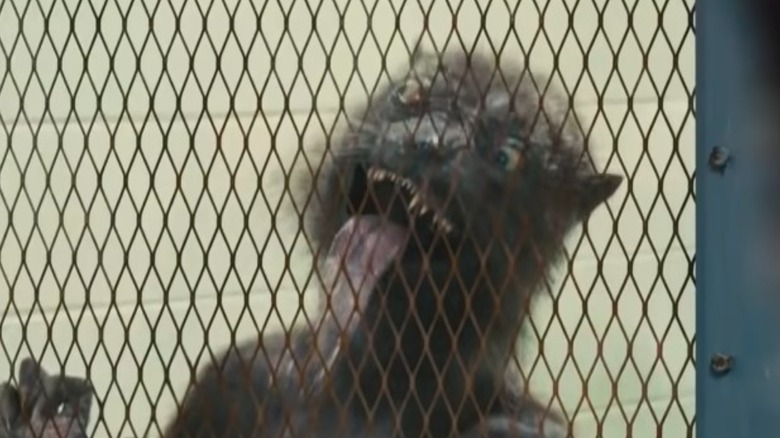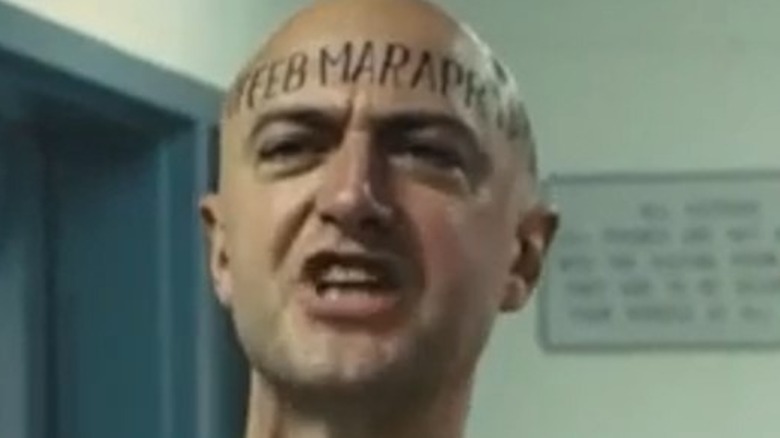Who Were The Other Belle Reve Villains In The Suicide Squad?
"The Suicide Squad" has splattered its mark all over theaters in a manner that'll have forensic pathologists scratching their heads for years to come. James Gunn made good on his promise that fans will be happiest if they "don't get attached" — beloved members of the DC Universe and the franchise in general were falling like dominos with surprised looks on what was left of their faces before the opening credits had even started to roll. That's what you get when you join Task Force X, though. Amanda Waller is a rough boss.
Still, not every monster and antihero was offered a blood-drenched work release opportunity. The Belle Reve Correctional Facility boasted a fair number of familiar, nefarious faces among its residents, all of whom presumably got stuck staying inside while their cellmates did the hard work of having their heads exploded. From Batman villains to Flash villains to other Batman villains, here's every other bad guy that we see in prison during "The Suicide Squad."
The day has come for a big screen Calendar Man
In the most high-profile case of the pot calling the kettle words that we're not allowed to repeat, Calendar Man calls Polka-Dot Man ... well, he calls him names that we're not allowed to repeat. The basic gist is that he thinks Polka-Dot Man is less than phenomenal.
Which is wild, considering that Calendar Man is Calendar Man. Played by Sean Gunn, Calendar Man is a Batman villain that took his time figuring out what his deal was. In the 1940s, he popped up dressing as each of the seasons, throwing autumn leaves at the Dynamic Duo to escape and absolutely pulling off a full-body daisy costume for springtime. He even dressed like a snowman for winter. He was nothing if not dedicated.
The post-Frank Miller years were hard on Batman villains, and Calendar Man got a Hannibal Lecter-esque reimagining for "Batman: The Long Halloween." The followup comic would see the introduction of his now-iconic ring of scalp months, and Tom King's run of Batman stories landed the villain with the ability to shed his skin once a year and be born anew. Say what you will about a life of crime in comic books, it never seems to leave you wanting for excitement.
Kaleidoscope gets her movie debut
It's hard to say why exactly. Maybe it's because the costume is fun to draw. Maybe, like Kite Man and Condiment King, Kaleidoscope is just the sort of underdog that writers root for. They must, since she survived almost 60 years of rewrites, retcons, and crises on a various Earths. We only get a brief look at Natalia Safran's version of the oft-overlooked character in "The Suicide Squad," but she definitely makes a visual impression.
Although she's infrequently utilized, Kaleidoscope has actually been around since the 1950s, though her most recent literary appearance came in 2011. In the DC canon, she was created by the Master, one half of Robby Reed after his infamous split. Reed not-so-coincidentally also dates back to the 1950s, though he hasn't appeared in any DC titles since 2011, either.
We don't get to see much of Kaleidoscope's powers in her brief, incarcerated cameo in "The Suicide Squad," which is a real shame, because she packs the kind of psychedelic punch practically begging for a visual treatment in film. By splitting and refracting light in a manner similar to her namesake children's toy, Kaleidoscope produces vivid visual hallucinations and realistic illusions. Maybe we'll get to see her bust out the colors in "The Suicide Squad 2."
Double Down brings the implied grossness to The Suicide Squad
Against all odds, Jeremy Tell takes the prize for "Grossest Supervillain" in a movie that features a man-sized weasel with the eyes of one of those squeezy stress dolls from back in the day.
Debuting in 2001's "The Flash: Iron Heights," Jeremy Tell, or "Double Down," is a remarkably obscure pull. The homicidal former con man came by his powers as honestly as a homicidal former con man can — after losing everything in a poker game, he went wild on his opponent, murdering him in cold blood.
The bad news didn't stop there. As it turned out, Tell's deceased fellow player had been in possession of a cursed deck of cards. Those 52 slips of cardstock flew through the air of their own free will and burned themselves into Tell's flesh, replacing the majority of his skin. As a result, he wound up with a dermis made of demonic cards that could peel off like Dino Damage in the nightmares of a spicy food enthusiast, revealing the musculature of the man underneath and zipping around murdering people with their razor-sharp edges.



